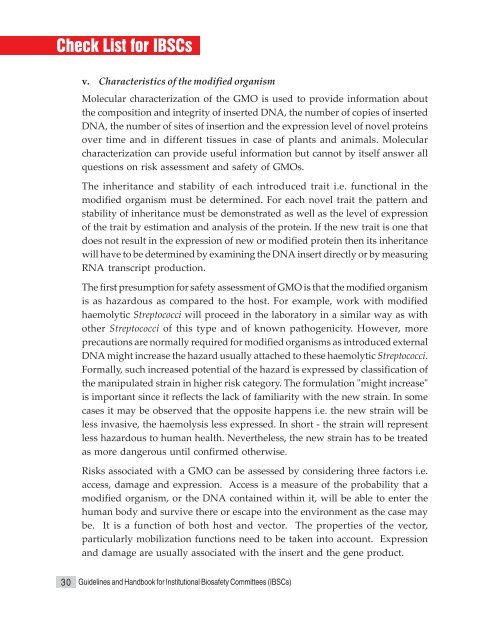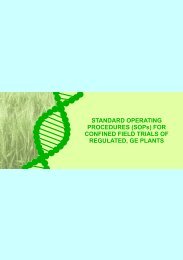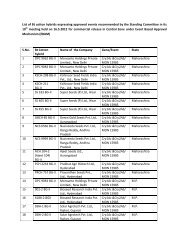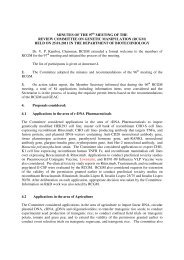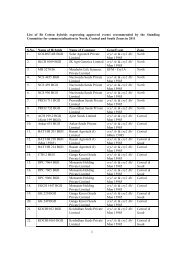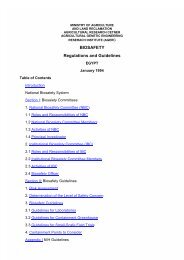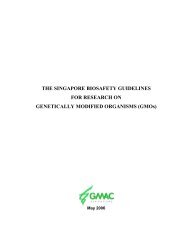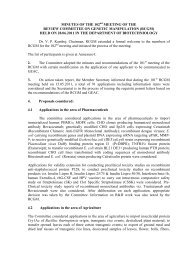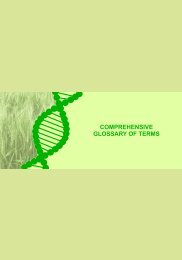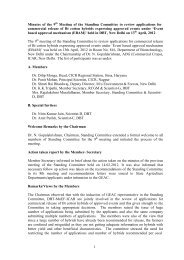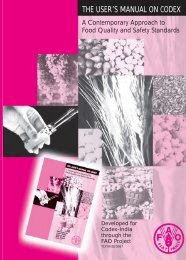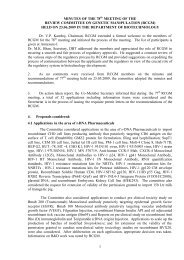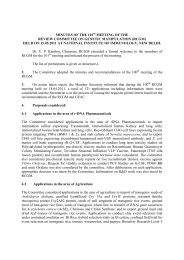Guidelines and Handbook for IBSCs - Department of Biotechnology
Guidelines and Handbook for IBSCs - Department of Biotechnology
Guidelines and Handbook for IBSCs - Department of Biotechnology
Create successful ePaper yourself
Turn your PDF publications into a flip-book with our unique Google optimized e-Paper software.
Check List <strong>for</strong> <strong>IBSCs</strong>v. Characteristics <strong>of</strong> the modified organismMolecular characterization <strong>of</strong> the GMO is used to provide in<strong>for</strong>mation aboutthe composition <strong>and</strong> integrity <strong>of</strong> inserted DNA, the number <strong>of</strong> copies <strong>of</strong> insertedDNA, the number <strong>of</strong> sites <strong>of</strong> insertion <strong>and</strong> the expression level <strong>of</strong> novel proteinsover time <strong>and</strong> in different tissues in case <strong>of</strong> plants <strong>and</strong> animals. Molecularcharacterization can provide useful in<strong>for</strong>mation but cannot by itself answer allquestions on risk assessment <strong>and</strong> safety <strong>of</strong> GMOs.The inheritance <strong>and</strong> stability <strong>of</strong> each introduced trait i.e. functional in themodified organism must be determined. For each novel trait the pattern <strong>and</strong>stability <strong>of</strong> inheritance must be demonstrated as well as the level <strong>of</strong> expression<strong>of</strong> the trait by estimation <strong>and</strong> analysis <strong>of</strong> the protein. If the new trait is one thatdoes not result in the expression <strong>of</strong> new or modified protein then its inheritancewill have to be determined by examining the DNA insert directly or by measuringRNA transcript production.The first presumption <strong>for</strong> safety assessment <strong>of</strong> GMO is that the modified organismis as hazardous as compared to the host. For example, work with modifiedhaemolytic Streptococci will proceed in the laboratory in a similar way as withother Streptococci <strong>of</strong> this type <strong>and</strong> <strong>of</strong> known pathogenicity. However, moreprecautions are normally required <strong>for</strong> modified organisms as introduced externalDNA might increase the hazard usually attached to these haemolytic Streptococci.Formally, such increased potential <strong>of</strong> the hazard is expressed by classification <strong>of</strong>the manipulated strain in higher risk category. The <strong>for</strong>mulation "might increase"is important since it reflects the lack <strong>of</strong> familiarity with the new strain. In somecases it may be observed that the opposite happens i.e. the new strain will beless invasive, the haemolysis less expressed. In short - the strain will representless hazardous to human health. Nevertheless, the new strain has to be treatedas more dangerous until confirmed otherwise.Risks associated with a GMO can be assessed by considering three factors i.e.access, damage <strong>and</strong> expression. Access is a measure <strong>of</strong> the probability that amodified organism, or the DNA contained within it, will be able to enter thehuman body <strong>and</strong> survive there or escape into the environment as the case maybe. It is a function <strong>of</strong> both host <strong>and</strong> vector. The properties <strong>of</strong> the vector,particularly mobilization functions need to be taken into account. Expression<strong>and</strong> damage are usually associated with the insert <strong>and</strong> the gene product.30<strong>Guidelines</strong> <strong>and</strong> H<strong>and</strong>book <strong>for</strong> Institutional Biosafety Committees (<strong>IBSCs</strong>)


